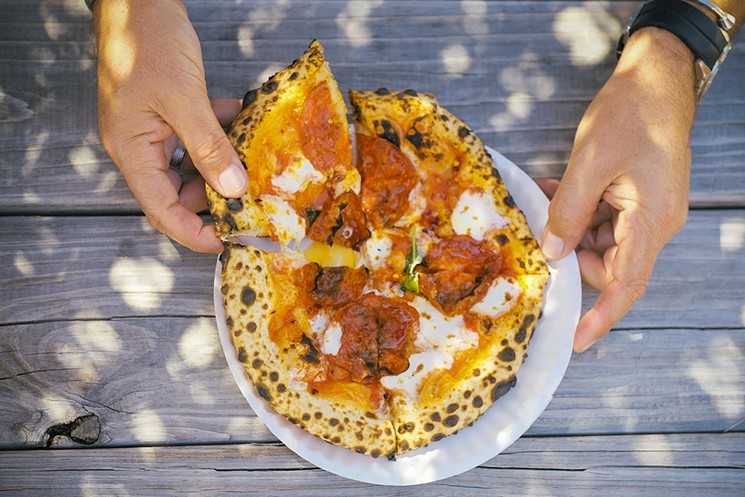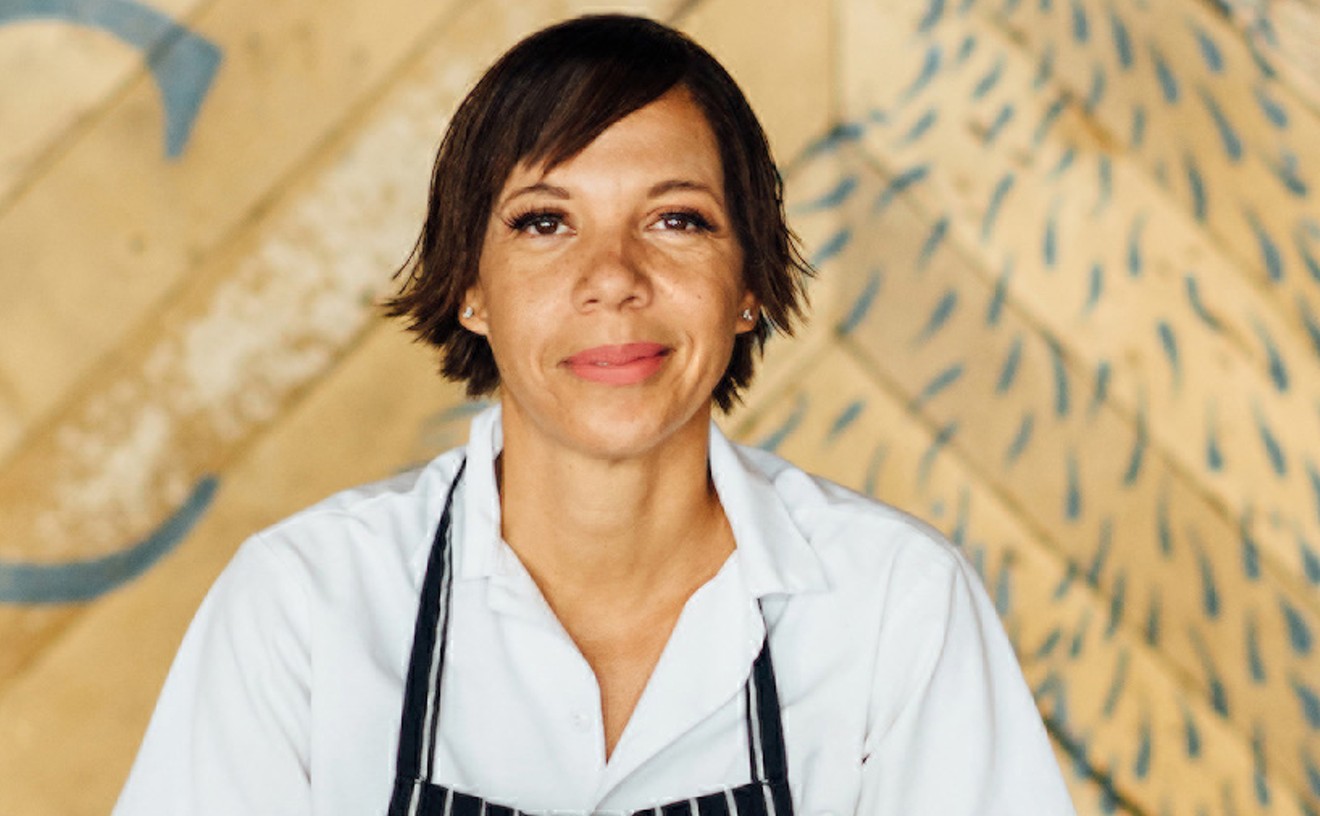Funky, graffiti-style caricatures of pizza, beer, and cigarettes are painted in red, orange, and yellow across the walls of a half-wooden, half-tented structure on the southeast corner of Jungle Plaza in the Design District. Inside, a team of cooks smears cheese and drizzles honey onto disks of dough laid out on metal baking sheets.
The 200-square-foot, hand-built structure looks nothing like other spaces in Miami's most luxurious shopping destination, home to world-renowned designer storefronts such as Prada, Burberry, Cartier, and Fendi.
This past October 17, a temporary, scaled-down version of the hipster Brooklyn restaurant Roberta's opened near the Tom Ford and Louis Vuitton boutiques. Three men and two women, flushed-faced and wearing damp headbands and flour-dusted white aprons, churned out pizzas spiced with chili flakes and soppressata. All the while, they maintained cheerful smiles.
Though temperatures sometimes linger in the '90s, Roberta's operates without air conditioning. Ingredients that must be kept cold, such as cheese and sauce, are stored in a refrigerated shipping container parked about 20 feet from the makeshift structure.
"Sure, logistically, it's more difficult to run a pop-up than most brick-and-mortars," says 40-year-old co-owner Brandon Hoy, sporting dark stubble on his chin. "But having a pop-up lets us show people a good time regardless of whether they're in Brooklyn or not."
Roberta's is one of four pop-ups that have debuted in the past six months. All serve food and drinks from spaces that haven't been retrofitted or newly constructed, as is typical in Miami. Some pop-ups are more ambitious than others, but each provides a cheaper alternative to the terrifyingly risky business of starting a restaurant.
"Pop-ups allow us to extend our outdoor season... to 365 days in places like Miami."
tweet this
The concept of a temporary eatery dates to at least the 1960s. In supper clubs and closed-door restaurants, chefs cooked off-the-wall meals for in-the-know customers, sometimes in the chefs' homes. In 2007, French chef Ludovic Lefebvre reintroduced the idea through a series of pop-ups across Los Angeles called LudoBites. They no longer exist, but many observers still consider Lefebvre the "king of the pop-up."
Since then, pop-ups have appeared in cities worldwide. David Barzelay's Lazy Bear in San Francisco, Sarah Gavigan's Otaku in Nashville, and Brooks Headley's Superiority Burger in New York are only a few. Some are an opportunity for established chefs to create something unorthodox, while others allow up-and-comers to test fare before opening permanent locations.
In Miami, Phuc Yea is credited with making the term "pop-up" mainstream. The temporary Vietnamese- and Cajun-inspired restaurant opened for a season in September 2011, when it took over downtown's Crown Bistro during dinner hours. As planned, it closed three months later, and two of the pop-up's partners, Aniece Meinhold and Cesar Zapata, went on to open the Federal Food, Drink & Provisions on Biscayne Boulevard. When that closed in August 2016, Meinhold and Zapata opened a permanent rendition of Phuc Yea inside the former Moonchine Asian Bistro space a few blocks away.
"We opened a pop-up out of necessity, not trend," Meinhold says. "The options for us were to open a pop-up or look for opportunities outside of Miami. At the time, it was popular in places like New York and Chicago but had never been done here."
One of the most active local pop-ups since Phuc Yea has been Sweet Melody Crafted Ice Cream Co. (786-376-2814, sweetmelodyicecream.com), which began operating in 2016. Owned by Mike Romeu, a wide-eyed 39-year-old with a stocky build and bristly brown mustache, the concept is named for and inspired by his 5-year-old daughter, Melody. In less than two years, he has scooped flavors such as Brie and apricot, and pecan and bourbon in restaurants like Pinch Kitchen and R House. He has set up small freezers at places such as Lincoln's Beard Brewing, where he scoops the ice cream himself. And he delivers pints to Niven Patel at Ghee Indian Kitchen.
This past September 30, he partnered with Mojo Donuts, a local doughnut shop in a strip mall in Westchester. On weekends, customers can add a serving of ice cream ($4 to $6) atop a doughnut or purchase individual pints of his more than 150 rotating flavors ($10).
"Pop-ups like this give my customers somewhere to go," Romeu says. "One day I just hope this gets large enough that I can have a storefront with my daughter's name on it."
In Coral Gables, 23-year-old Sachi Statz and 30-year-old Andres Vega operate the Cuban-inspired pop-up Sansara (1315 Ponce de Leon Blvd., Coral Gables, 305-432-4661) Sunday mornings at Tinta y Café, which is owned by Statz's mother and uncle. The couple, who met and fell in love at the Miami Culinary Institute in 2015, quit their jobs this past April to create their version of "upscale Cuban food," which debuted in June. Since then, Statz has run Sansara on Sundays and managed Tinta y Café during the week.
"In this industry, one second you're in and the next you're out," Statz says. "Popping up allows us to work out the kinks and test out something that isn't being done."
Statz and Vega serve croqueta cake Benedicts, where a savory ham patty is stacked atop a flaky biscuit and drizzled with lime hollandaise ($15); tomato confit toast, made with sweet and tender cherry tomatoes ($12); and fried eggs with rich maduro hash ($11). Sometime in November, Sansara will serve dinner too.
"When we create Sansara inside the café, we completely flip the restaurant," Vega says. "We bring in our own tables, vintage plates, silverware, and even different napkins. A pop-up is... exciting for the first couple of weeks, but eventually you want to find a home."
Six miles north, in Brickell, the Craftsman (900 S. Miami Ave., Miami, 305-400-8226) moved into the former Brother Jimmy's BBQ space in late September. The concept, which debuted this past March in New York's Harlem, will remain in Miami for about a year, serving whiskey and bourbon cocktails with hearty sandwiches such as Reubens, Cubans, and cheesesteaks ($7 to $20).
Dave Casey and Phil Quilter, the 45-year-old co-owners of the Craftsman NYC, teamed up with 34-year-old Dustin Elmalem, who operated three South Florida Brother Jimmy's locations until this past June, to open the Craftsman Miami.
Their term is unclear. "We're going to ride it out for as long as we can," Elmalem says.
Roberta's in the Design District (entrances at 3801 NE First Ave. and 140 NE 39th St., Miami) is different from the others in that it was built from scratch. The concept debuted in 2008 in Brooklyn's Bushwick neighborhood and became famous for hipsters and tiki nights. Customers have included the Clintons, Beyoncé, and Jay-Z.
In 2010, Roberta's opened a mobile operations department responsible for coast-to-coast pop-ups. They have lasted anywhere from a few days to four months. The company owns three mobile pizza ovens, which have been parked in cities across the nation, from Manchester, Tennessee, to Indio, California.
"Pop-ups allow us to extend our outdoor season from three months in New York to 365 days in places like Miami or California," cofounder Hoy says.
While Roberta's pop-ups specialize in premium pizza, the Brooklyn restaurant is a full-service operation attached to a casual take-out area and a bakery. "Pizza is the backbone of what we do at Roberta's," Hoy says. "When we go out on the road, it's the easiest product to re-create well."
At the Miami pop-up, each pie is finished with a distinct ingredient. For example, the Bee Sting calls for a squeeze of sweet honey and a layer of soppressata (Italian dry salami); the Famous Original enhances a traditional mozzarella recipe with caciocavallo; and the White Guy uses ricotta garlic for extra flavor. Once assembled, pies are fired for 90 seconds inside a brick pizza oven attached to an aqua-blue trailer. Prices range from $11 to $14.
The owners also operate a Roberta's take-out spot in Midtown Manhattan, along with the Michelin-starred tasting-menu concept Blanca, where 37-year-old chef and co-owner Carlo Mirarchi cooks most nights. The company hasn't been above controversy, having recently reached a six-figure settlement for unpaid wages and been sued by a disgruntled investor.
Despite those legal issues, Roberta's Miami is scheduled to serve a small but mighty menu daily until April 2018. Hoy would not disclose the cost to set up and run the pop-up but says "it is much less expensive than opening a brick-and-mortar."
Plans are to host events and build additional shaded structures in Jungle Plaza.
"Where these pop-ups lead us, who knows?" Hoy says. "On one side, we look to see if a market is receptive, but on the other, we just want to show people a good time."













